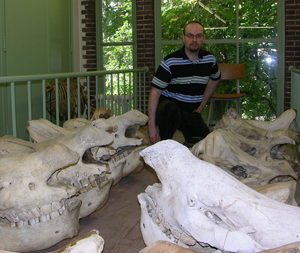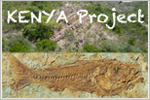Oldest hominid skeleton unveiled
LMU researcher Ioannis Giaourtsakis studies Ardipithecus’ environment
01.10.2009
These results open a new chapter on human evolution by giving insights into a previously poorly understood period, only a few million years after the human line diverged from that leading to chimpanzees. As part of a large international team under the lead of professor Tim White, Berkeley, USA, LMU researcher Ioannis Giaourtsakis participated in the study of fossils that have been discovered close to the remains of Ardipithecus ramidus, the earliest skeleton known from the human branch of the primate family tree. Ardipithecus is older and more primitive than Australopithecus, which is known by several species – including the famous skeleton of “Lucy”. The results provide surprising insights into the anatomy, behaviour, evolutionary relationship and ecological preferences of the early hominid. LMU palaeontologist Ioannis Giaourtsakis and his international collegues analyzed with a variety of methods the morphological and chemical properties of animal fossils to reconstruct the environmental setting in which Ardipithecus found his habitat. They have concluded that on the ground the hominid was able to walk on two legs but as a capable climber preferred the wooded habitats: Bipedality therefore developed before hominids spread to the savannah and adopted a different lifestyle.
 Picture: Ioannis Giaourtsakis examining extant and fossil skulls of rhinoceroses. Through the detailed studies of fossil animals and plants, scientists can reconstruct the environmental setting and ecological habitats, where Ardipithecus ramidus has evolved in Ethiopia 4,4 million years ago.
Picture: Ioannis Giaourtsakis examining extant and fossil skulls of rhinoceroses. Through the detailed studies of fossil animals and plants, scientists can reconstruct the environmental setting and ecological habitats, where Ardipithecus ramidus has evolved in Ethiopia 4,4 million years ago.
Publication
Special Issue Science, Vol 326; 02 October 2009
Doi: 10.1126/Science.1175822
Contact
Dipl.-Geol. Ioannis Giaourtsakis
Department für Geo-und Umweltwissenschaften
Paläontologie & Geobiologie
Tel.: 089 / 2180 – 2706





